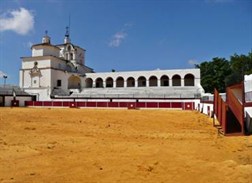Plazas and Ermitas: Trucios, Puebla de Sancho Pérez and Medinilla
 Trucios (Turtzioz in Euskera) is a town in the Biscay region (Bilbao) of just over 500 souls which is a source of wonder on account of the amount of bullrings in it: each quarter has its own structure which faces a church. Both the plazas and the shrines date back to the mid-eighteenth century. The bullfights, as in other areas of Spain, were linked to religious festivals in honour of patron saints. The facilities are simple, circular or square, are equipped with side walls and wooden protection barriers. The Ermita de la Trinidad (in the Gordón quarter, eighteenth century) and the Ermita de San Roque (eighteenth century) much be mentioned. The latter is equipped with a ring that dates to 1692, which was originally irregular in shape, after a restoration in 1983 it was equipped with it current circular shape. Of note is the Ermita de la Caridad, also known as that of Santa Isabel. This shrine, which was built in the second half of the seventeenth century, is in a severe Baroque or Classical style. The bullring is circular with side walls as well as barriers made of stone. It has a podium with steps and was built around 1755. Near Trucios, in Artzentales, is the church of San Antolín (Saint Antonius of Pamiers), also dating from the early eighteenth century (probably 1705), in front of which there is an irregular space used for bullfighting.
Trucios (Turtzioz in Euskera) is a town in the Biscay region (Bilbao) of just over 500 souls which is a source of wonder on account of the amount of bullrings in it: each quarter has its own structure which faces a church. Both the plazas and the shrines date back to the mid-eighteenth century. The bullfights, as in other areas of Spain, were linked to religious festivals in honour of patron saints. The facilities are simple, circular or square, are equipped with side walls and wooden protection barriers. The Ermita de la Trinidad (in the Gordón quarter, eighteenth century) and the Ermita de San Roque (eighteenth century) much be mentioned. The latter is equipped with a ring that dates to 1692, which was originally irregular in shape, after a restoration in 1983 it was equipped with it current circular shape. Of note is the Ermita de la Caridad, also known as that of Santa Isabel. This shrine, which was built in the second half of the seventeenth century, is in a severe Baroque or Classical style. The bullring is circular with side walls as well as barriers made of stone. It has a podium with steps and was built around 1755. Near Trucios, in Artzentales, is the church of San Antolín (Saint Antonius of Pamiers), also dating from the early eighteenth century (probably 1705), in front of which there is an irregular space used for bullfighting.
 A similar case is that of Puebla de Sancho Pérez (picture). The bullring is placed against a religious structure, the Ermita de Nuestra Señora de Belén. It is a religious building dating back to the fourteenth or fifteenth century and rebuilt in the eighteenth. According to some sources, the plaza dates back to the original architectural plan, which would make it the oldest of the peninsula. It has a mainly square shape.
A similar case is that of Puebla de Sancho Pérez (picture). The bullring is placed against a religious structure, the Ermita de Nuestra Señora de Belén. It is a religious building dating back to the fourteenth or fifteenth century and rebuilt in the eighteenth. According to some sources, the plaza dates back to the original architectural plan, which would make it the oldest of the peninsula. It has a mainly square shape.
Even in Medinilla, the ancient fief of the Dukes of Béjar, the bullring leans on a shrine, that of Fuente Santa. Quadrangular in form, according to some documents it dates from the late seventeenth century. Already in use in 1685, as a permanent enclosure, it was used at least until 1784. The link between the Church and bullfighting culture can be traced in the popular legend related to the building of the shrine at the time of the Reconquista according to which when a knight rode behind a bull, and came to this place both the bull and the horse stopped, the man dismounted and found an image hidden in the grass. The church was to be supposed to have been built near the place where there was once a fountain.
